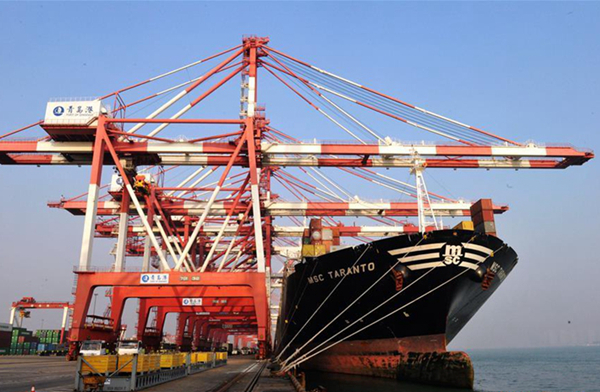New globalization trends in Chinese firms
- By Long Yongtu
 0 Comment(s)
0 Comment(s) Print
Print E-mail China.org.cn, February 25, 2017
E-mail China.org.cn, February 25, 2017
|
|
|
A foreign cargo ship is seen at Qingdao Port in east China's Shandong Province, December 8, 2016. China's exports in yuan terms ended previous drops to rise 5.9 percent year on year in November, while imports continued to pick up steam by increasing 13 percent, customs data showed on December 29, 2016 (XINHUA) |
With its outbound direct non-financial investment reaching a record high of US$145.67 billion in 2015, China's accumulated outbound direct investment, for the first time, stood above US$1 trillion by the end of 2015. In 2016, several major deals were announced, including Midea Group acquiring German robot maker Kuka for more than 4 billion euros, and ChemChina's US$43 billion takeover of Swiss group Syngenta. Such direct Chinese investment in foreign countries has expanded almost ten times in the past decade, and the fields of investment and destinations of companies that go overseas have become more diversified.
China is a large beneficiary of globalization. It became the world's second largest economy in 2010 and the world's largest trading nation in 2013.
But the world's globalization process seems to have decelerated since the financial crisis in 2008. Official data shows that global trade increased only 2.8 percent year-on-year in 2014, marking the first time that the trade growth rate was lower than that of GDP. The number of protectionist measures introduced by G20 countries skyrocketed from 381 items in 2010 to 1441 in late 2015. And after the shocking exit from the EU by Britain, most of the presidential candidates and later the president-elect of the United States opposed the Trans Pacific Partnership, which was believed to be a facilitator of freer trade in the Asia Pacific.
But in my opinion, these are only temporary phenomena in the economic cycle and do not represent long-term global trends. There are three factors in globalization. First, the rapid development of science and technology; second, international investment and trade by multinational companies; and third, industrial structural adjustment around the world. So long as these factors are still in full swing, the process of globalization will not be stopped.
Chinese firms are now in the period of globalization. Though they are sometimes believed to have little core technology and low profit, they are bound to develop further and show the following trends.
First, Chinese companies that "go global" will see rapid growth. China's outbound direct investment will double to between US$250 billion and US$300 billion by the end of 2020, and total outbound direct investment during the 2016-2020 period is expected to reach US$1.1 trillion.
Second, the globalization of Chinese firms will help upgrade Chinese industries. Since its entry into the WTO, China has made a lot of effort in increasing the technology and additional value of its exported goods. High-tech goods contributed 17.5 percent of the worth of all exported goods in 2001, and the figure climbed to about 30 percent in 2016. Midea's acquisition of Kuka in May last year was aiming at increasing its own productive efficiency and upgrading its manufacturing ability by using Kuka's advanced technology in industrial robots and automation. Cases like this prove that Chinese firms are trying to acquire patented and core technologies in the process of globalization, which will also help China become a manufacturing powerhouse.
Third, Chinese firms are becoming more diversified in their global expansion. After gaining a foothold in some of the world's most popular investment destinations in the past one or two decades, Chinese companies are now exploring emerging destinations and are thus more diversified than they used to be. For example, since first going overseas in 1997, Huawei now has branches or offices in more than 160 countries.
Fourth, Chinese firms will move up the value chain in the process of globalization. Many Chinese companies used to rely on their advantages in labor and land, but now that these advantages are shrinking they choose to go overseas and bring home outstanding technology and brands.
Fifth, Chinese firms will improve their management and become more aware of their due social responsibility. Chinese companies paid dearly for their neglect of local culture in the early days of their globalization processes. Now more and more companies are paying increasing amounts of attention to local operation and social responsibility. Fuyao Group kept the workers' union after acquiring a factory in the state of Illinois in 2014, though the agreement allowed it to shut it down. In 2015, the company donated 7 million dollars to a local university after investing in the state of Ohio.
In summary, I am optimistic about the globalization of Chinese companies. Though it is a daunting process for companies to reach out to foreign countries, I believe the trend of globalization will not be reversed.
Long Yongtu is chairman of the CCG (Center for China and Globalization) Advisory Board. He was China's chief negotiator when the country sought to enter into WTO.
The article was translated by Zhang Lulu. Its original unabridged version was published in Chinese.
Opinion articles reflect the views of their authors, not necessarily those of China.org.cn.







Go to Forum >>0 Comment(s)